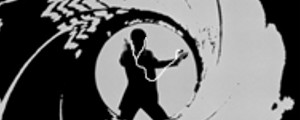This James Bond article was getting more hits than anything else on my old site, so I thought I’d bring it here to my updated blog. I originally wrote it in 2006 (circa Casino Royale) while interning at Soundlounge sonic branding agency in London. If you want to learn more about composing, check out my new podcast, called Composer Quest.
Dum da-da da dum dum | Understanding the James Bond Melody
 In order to understand how Bond music became Bond music, we must look back to the origin of the series. The signature “James Bond Theme,” written by Monty Norman and arranged by John Barry for 1962’s Dr. No, is without a doubt one of the most instantly recognizable film tunes. And it’s no surprise; the theme has been musically quoted in every one of the Bond films.
In order to understand how Bond music became Bond music, we must look back to the origin of the series. The signature “James Bond Theme,” written by Monty Norman and arranged by John Barry for 1962’s Dr. No, is without a doubt one of the most instantly recognizable film tunes. And it’s no surprise; the theme has been musically quoted in every one of the Bond films.
The first few seconds of the piece hold the four ominously subdued notes forever associated with Mr. Bond: first B, then up a half-step to C, up another half step to C#, then back down to C. This simple chromatic rise and fall creates a sense of unsettling mystery, as if the music is pacing back and forth, frantically trying to decide where to go next.
James Bond Theme – Introduction
[audio:https://www.charliemccarron.com/mediaftp/bond_music/James%20Bond%20Theme%20-%20Introduction.mp3]
Though the Vic Flick guitar riff enters and firmly roots us in the key of E minor, its melody is atypical. The high D# jumps up to stab like a knife. Though this note is still a member of the E melodic minor scale, in a traditional melody the D# would lift up to an E instead of sliding down to and hanging on the D natural. It’s another subtle way Norman and Barry have crafted surprise and mystery through melody.
James Bond Theme – Guitar Riff
[audio:https://www.charliemccarron.com/mediaftp/bond_music/James%20Bond%20Theme%20-%20Guitar%20Riff.mp3]
Finally, after the blaring trumpets have entered and fully developed the theme, they bust into a swinging, ornamented variation of the opening guitar riff. But it’s not as straightforward as it seems. A careful ear will notice that the second trumpet seems to be playing in a different key. In fact, this “harmonized” melody, sandwiched between the top trumpet and the bass, would actually feel more at home in the key of C# minor than E minor. These breaks in musical “rules” are inherent in Bond melodies, but then again, since when have Bond films been about following the rules?
James Bond Theme – Brass Harmony
[audio:https://www.charliemccarron.com/mediaftp/bond_music/James%20Bond%20Theme%20-%20Brass%20Harmony.mp3]
From Russia with Key Changes | Outlining the Chord Progressions
Once this melodic quirkiness and mystery had been established in Dr. No as the distinctive Bond sound, it was only natural for them to continue through into the following films. The numerous title theme songs draw from this chromatically unconventional sense of melody. From Matt Monro’s augmented 2nd in “From Russia With Love” to Nancy Sinatra’s tritones in “You Only Live Twice,” the title songs often subvert the listener’s sense of comfort by jumping unconventionally from note to note.
But the Bond way of surprising the listener through music is not simply a matter of throwing an odd note in here and there. Each note has been carefully planned to fit within the chord progression of the song. In fact, the chord progression often becomes the primary element of surprise in a Bond song. And as the “James Bond Theme” set the standard for melody, it was the following string of title songs that set the standard for modulation. Whereas the “James Bond Theme” remains in the key of E minor, “Goldfinger” jumps abruptly from key to key twenty-eight times in under three minutes! Add to this the augmented 5th created by the “wah-waaah-wah” of the trumpets, and you have a song unlike any of its rivals on the pop charts. Voted as the UK’s favorite Bond theme in a recent MORI poll, the distinctively Bond-esque “Goldfinger,” has become a stick against which all Bond themes are measured.
Goldfinger – Key Jumps Highlighted
[audio:https://www.charliemccarron.com/mediaftp/bond_music/Goldfinger%20-%20Key%20Jumps%20Highlighted.mp3]
So how do these unconventional chord progressions make a song Bond-esque? One technique commonly employed by Bond music is common-tone modulation, as in the “Goldfinger” E major to C major transition, where E is the common tone between the two chords. This technique is also employed from minor key to minor key. In the end of “Live & Let Die,” Paul McCartney’s bass line firmly plants the final orchestral section in G minor, but suddenly freezes on an E-flat minor chord. Another heart-stopping common-tone modulation occurs in “Thunderball.” While Tom Jones sings the line “He looks at this world and wants it all,” the violins hold the common tone of A until the key changes underneath from B-flat minor to D minor. In this haunting moment at the word “all,” they sneak back into the chromatic James Bond theme.
Thunderball – Common-Tone Modulation
[audio:https://www.charliemccarron.com/mediaftp/bond_music/Thunderball%20-%20Common-Tone%20Modulation.mp3]
The beauty of these common-tone modulations is that they pull the rug out from under listeners. When you expect major, you get minor, and vice-versa. This uncertain blending between the two is present through the entire series in different forms. In “Moonraker,” major and minor elements are simply combined. The piano, playing a line with a minor 6th, is in direct competition with the strings and horns, which pull the song into a major key. These ironic juxtapositions in Bond music parallel the mysterious juxtapositions in Bond films; an island that looks pleasant enough for the next holiday trip may secretly house a sinister den of villains determined to take over the world.
Bond’s Band | Listening to the Instrumentation
So now that we have the basic recipe for an authentic Bond song, we can examine the instrumentation that gives it flavor. Just as there are unwritten rules against, say, baking a cake using chili sauce, there are “rules” to arranging songs in the classic Bond style. Of course, there are instrumental variations over the four decades of music, mostly due to new digital production techniques. Indeed, the series of Bond music can be studied as a microcosm of the progression of pop music in the last half-century. However, there are clearly consistent elements that say to the listener, “Now this is Bond music.”
- Raw brass – Established early on by Dr. No, Goldfinger, and Thunderball, the overblown trumpets and brass have punched out stinger notes through many of the title songs. Amidst the icily restrained backdrop of the “Goldeneye” intro, the trumpets cut through the dreamy world of harps and strings and bring us back into a harsh reality.
- Expressive strings – From the free-flowing opening of the “From Russia with Love” to the seductive opening of “The World is Not Enough,” the use of strings adds emotional depth to the songs. Even in Madonna’s heavily digitized “Die Another Day,” the strings put meat on the bones of the electronic beats.
- Distinct percussion – Although some of the more recent songs have scaled back to just a standard drum set, the “classic” Bond songs draw from the orchestral percussion instruments. The congas in “Live & Let Die,” the jingle bells in “Goldfinger,” the triangle in “Moonraker,” and the marimba in “You Only Live Twice” are just a few of the ways Bond songs get their rhythmical legs.
- Vic-style guitar – Vic Flick’s vintage guitar sound from the original James Bond theme has been brought back more recently in Sheryl Crow’s “Tomorrow Never Dies” and Chris Cornell’s “You Know My Name.” Though the electric guitar has not been featured in very many of the theme songs, its appearance in the original theme is so distinctive that these newer title tracks are instantly recognizable as Bond-esque.
Female Diva or Male Superstar – Perhaps for their musical experience, perhaps for their recognizable voices, or perhaps for their star power in winning hit singles, these celebrity singers are recruited to follow in the footsteps of the early Bond singers Matt Monro and Shirley Bassey. The Bond style requires versatility as a singer, from the seductively quiet introductions to the powerfully epic climaxes.
Did Cornell Play His Cards Right? | Analyzing the Casino Royale Theme Song
In an interview with the BBC, Chris Cornell discussed why he was chosen to perform the Casino Royale theme song, and what the Bond gurus were looking for. In Cornell’s words, they “didn’t want to echo any recent Bond theme songs…their attitude was that they wanted somebody who vocally would be unapologetically masculine. David Arnold’s quote was that they didn’t want the ‘bird with the broken wing’ type of singing.” It’s no secret that the Brosnan-era theme songs have been received with mixed reviews. Though Madonna’s “Die Another Day” reached number three in the UK charts, it was only the ninth favorite Bond song out of twenty-two, according to the MORI poll. The other three Brosnan-era songs were ranked lower. Perhaps in seeking a hit single, the writers of these songs strayed too far from the James Bond path.
We all know that James can survive driving his motorcycle off a cliff by skydiving towards a falling plane and piloting it to safety. But when it comes to the branding of the James Bond series, the producers must be very careful. Bond’s essence is firmly established, and McDonald’s would abandon the golden arches before the James Bond team would consciously destroy the gun-toting, woman-seducing, world-saving aura of James Bond. However, Casino Royale is currently under the microscope for its bold move away from some things seen as inherently Bond. Thanks to the enormous and devoted Bond fan base, each new film is critiqued for any un-Bond behavior. The uproar created by Daniel Craig’s blonde hair alone shows how picky these fans can be. So, of course thousands upon thousands of scrutinizing ears have been listening in on Chris Cornell and David Arnold’s new theme song to see if it, too, takes Bond in a new direction.
On the surface, “You Know My Name” doesn’t seem to musically quote any of the “classic” themes, as done very directly in “Goldeneye” and “License to Kill.” However, a close listen reveals a few subtle elements we’ve found in many “classic” Bond songs. Remember the common-chord modulation used to surprise the audience? Cornell and Arnold use this technique multiple times in the track. During the verses, a B minor chord changes to a G minor chord. During the chorus, G major becomes E major. Both these chord changes keep listeners on the edges of their seats. Remember the oddly harmonized trumpets in the original James Bond theme that seemed to be playing in two different keys? This technique is back in Cornell’s voice doubling; one voice sings in the key of B minor while the other would typically be found in D minor. Although listeners may not hear a classic Bond melody in the song, these subtle musical references subliminally stamp the song as Bond music.
You Know My Name – Cornell Harmony
[audio: https://www.charliemccarron.com/mediaftp/bond_music/You%20Know%20My%20Name%20-%20Cornell%20Harmony.mp3]
In terms of orchestration, however, “You Know My Name” does seem to be a departure from the “classic” Bond sound. The trumpets and strings are present, but mostly as a backdrop to Cornell’s mountain of guitar. Like several of the more recent songs, the percussion is limited to a standard drum kit, with a bland backbeat indistinguishable from a typical pop song. And the choice of the raw-sounding Cornell as a vocalist is a far cry from the smooth British Matt Monro or Tom Jones. The song’s packaging is enough to place it on the charts, but only time will tell if the Bond elements are strong enough to place it on the Bond theme favorites list ten years from now.
To Whom It May Concern | Looking Forward
However different it may be from the classic Bond sound, “You Know My Name” is a product of its time, just as the original Bond theme was forty-four years ago. It raises an important question: can a brand’s music stay true to its roots while still being fresh and current? Some argue that Bond’s coolness was established by the original theme in 1962, and shouldn’t be tinkered with. Others argue that each era should have their own Bond music, never mind the past. Clearly, the classic sound has been tinkered with, sometimes successfully, sometimes unsuccessfully. Only through musical ingenuity and unique orchestration can a song become timeless, which poses a challenge to Bond composers. They must delicately balance the need to create an original piece of music with the need to retain its Bond flavor. So to whomever wants to write the next James Bond theme song, a few words of advice: remember that a classic Bond song is more than a pop hit, remember the giants on whose shoulders you’re standing, and remember to make it Bond…James Bond.
Thanks for checking out my James Bond research. If you want to learn more about composing, take Composer Quest for a spin.




None of the music links seem to work form me : (
Otherwise interesting article and it would be cool for it updated for the two more recent releases.
Thanks very much for letting me know about that, Chris. I fixed the music links.
I have some other projects to get to before I analyze the new Bond themes, but I will throw it out there for anyone else to analyze the most recent themes and post a comment!
Thanks for stopping by!
Hi Charlie. I’d like to thank you so much for this. Our job in Year 9 Music class is to compose a one-minute James Bond piece based on the scene and I’m doing exactly a short introduction scene to James Bond based on the four-note B C C# C “leidmotif” – our current topic of the project – and the exciting brass instruments the accomplishments of James Bond. Again, thanks!
Ha, cool assignment! Glad my article helped you out.
BTW, do you think you’ll be posting your composition somewhere online?
Excellent article, though if you’re doing future edits, you want the term ‘subliminally’ rather than ‘subconsciously’; either that or ‘unconsciously’.
I’ve always had a tendency to stray outside of keys and use three frets in a row, nice to see that I’m not the only one and it may have been an unconscious influence all along.
Thanks for the feedback, John.
Does the song for Skyfall follow similar patterns?
Charlie, maybe you can settle an argument for me . . . I argue that Paula Abdul’s 1990 hit, “Blowing Kisses In the Wind” IS, or would/could be music fitting for a James Bond film. I can’t explain it musically, don’t know the language, but when I hear it, I hear a JB tune. I’ve added it to some of my homemade Bond CD’s and it fits right in. OK, Paula Abdul is no Shirely Bassey voice-wise, but musically, isn’t the tune Barry-esque?
Hey Chuck, good question. I’d never heard “Blowing Kisses In the Wind” before, but that has some of the weirdest chord progressions I’ve ever heard in a hit song. I think one chord change that makes it seem really Bond-like is the F# Major to D Major at 1:57. It’s the same strange chord change as “Goldfinger” (E Major to C Major). Thanks for the interesting comment!
I’m tempted to say that “Blowing Kisses in the Wind” associates itself with Bond not because of chord structure to the original Bond riff, but to Gladys Knight’s “License To Kill” – and perhaps more so because we’ve grown accustomed to associating the synthesizers in LTK with a Bond song.
KK,
I appreciate your comment. Possibly. LTK (1989) came before Blowing KIsses (1991). However, I did not discover LTK until AFTER Blowing Kisses. I was having problems with the Bond franchise at the time and had stopped watching them after Man With the Golden Gun. I prefer to laugh WITH my heroes and not AT them. I’ve backtracked some, thanks to DVD’s and found that after Moore they started treating Bond with more respect. I liked the LTK theme a lot because it reminded so much of Goldfinger. I would like to see the music make the same move toward being more respectable, classy, and memorable; themes you would be proud to hum or whistle to yourself.
Thanks for the reply Charlie. So, that’s how you describe it in ‘music language’ . . . OK. There are others factors as well . . .the mood, or tone of the piece; the lyrics (a Bond girl realizing she can’t keep him?). I do picture Connery’s Bond, BTW, and perhaps a bit of influence by the Bond of the novels rather the movies. For a pop song I also thought it is kinda classy. Just saying.
Charlie, one other matter . . . do you think we’ll ever hear, “The OO7 Theme” again in the movies? Not the “James Bond Theme”, but the ‘007 Theme’ (‘007 Takes The Lektor’: FRWL)? I think the last movie I heard it played was ‘Diamonds Are Forever’.
Got what I beleive is a good JB lyric. Need help with the score ( I’m not a musician) and getting it auditioned. Please reply soon.
Would appreciate contact at my email address: dahisida@aol.com. Thank You.
Thank you so much for your wonderful article — I loved it. It confirms much of what I have always thought makes for a classic Bond theme. I would love to hear your ‘take’ on “Surrender,” the David Arnold composition which, at the last minute, was pulled in favour of the Sheryl Crow effort, which I consider to be a mistake. It doesn’t “fit” with the rest of the film score, and “Surrender” works SO much better when run over the opening titles sequence.
“Surrender” has it all (almost) — and evokes the musical grammar of “Dr. No” and “Goldfinger.” Beautifully bold, ‘swaggering’ brass (which provides the “sex”) to open, lovely, expressive, almost nostalgic strings, devastating, ‘punchy’ single-note brass bursts (the “violence” counterpointing the sex) to punctuate the strings, and K.D. Laing’s stunning, soulful vocals. A sense of danger and foreboding throughout. The only thing missing is the Vic Flick guitar.
Anyway, sorry, I’d love to know what you think. I’ve included the link to a youtube video which plays “Surrender” over the ‘as-released’ titles sequence. Again, thank you for a fascinating article.
https://www.youtube.com/watch?v=6zIbOL8SSCY
Huh, I hadn’t heard “Surrender” before. I actually kind of like the Sheryl Crow song, but “Surrender” definitely feels more old-school Bond. Thanks for reading!